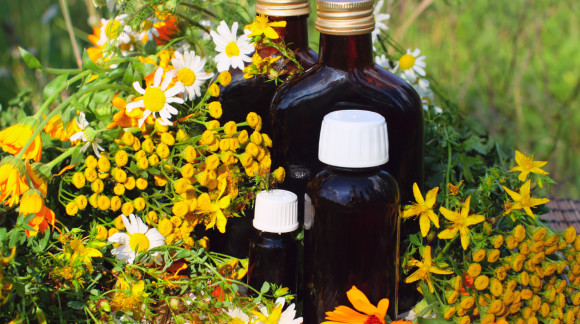How to Grow Your Own Medical Herb Garden

Plant-Based Healing
Plant-based healing is an ancient practice that is quickly gaining momentum in the 21st century. As the spread of disease continues and obesity rises, many are turning to alternative forms of healing through the medicinal properties of plants.
Thousands of plant varieties exist. Each is beneficial to the body in a unique way. However, simplicity is key when starting a medicinal garden. By selecting a few plants and helping them grow you will become eager to grow other plants.
Popular Medicinal Plants
The following is a list of popular medicinal plants with the greatest health benefits:
- Aloe Vera – Treats burns, wounds and cuts, and skin allergies, and is also fit for consumption to help digestive problems.
- Marsh Mallow – The roots of the plant can be used to treat insect bites and aching muscles. It is also fit for consumption to treat urine problems and ulcers.
- Pot Marigold – Externally used for insect bites and sore eyes, and to aid in reducing fevers and infections.
- Chinese Yam – Known to treat fatigue, diarrhea, dry coughs, diabetes and poor digestion.
- Lemon Balm – Treats herpes, insomnia, upset stomach, depression and fevers.
Other medically beneficial plants include:
- Siberian Ginseng
- Sea Buckthorn
- Tree Tea
- Peppermint
- Evening Primrose
- Turkey Rhubarb
- Milk Thistle
- Feverfew
- Fenugreek
- Slippery Elm
- Stinging Nettle
- Angus Castus
- Great Burdock
- Gotu Kola
- Chamomile
- Globe Artichoke
- Echinacea
- Chickweed
Planning Your Garden: Three Factors to Consider
Once you’ve researched the plants you wish to grow you need to consider the three main factors of your garden: location, layout and plant purchases.
- Location
How much room do you have to dedicate to your garden? How well does the soil drain? How much sunlight is available? Review the needs of your starter plants to ensure they will grow in the environment you have available.
- Layout
If your plants will grow large, like Marsh Mallow, they need space away from other plants to avoid overcrowding. Chamomile and Chickweed thrive in raised beds and lemon balm does well in an individual container. Do your research and create a layout.
- Plant Purchases
Will you be purchasing seeds or plants? If you purchase seeds it is helpful to consult a local gardener about the optimal planting time for your garden plants. For example, some seeds do better when planted in the winter or stored in your freezer to germinate.
Regular Maintenance
It is easy to get discouraged if your plants don’t take off immediately or die after planting. As living organisms, plants require the basic needs to live (water, nutrients and sunlight) as well as special attention to other factors like weather and insects. Each failed attempt makes you better prepared for the next.
Your attempt to garden, whether successful or not, is beneficial to your health. Gardening is one of the most popular hobbies of Americans. A 2012 study reported that nearly half of all Americans gardened in the last year – approximately 164 million people. While tending to your garden you are in good company.
Additional Resources
- A-Z Medicinal Herb Chart by Common Name, by anniesremedy.com
- How to Start a Medicinal Herb Garden, by frugallysustaninable.com
- How to Grow a Medicinal Herb Garden, by gardenguides.com
- Grow Your Own Medicinal Herb Garden, by apartmenttherapy.com
- Herb Gardens, by herbgardening.com
- 15 Most Effective Medicinal Herbs to Grow in Your Garden, by Farhan Ahsan
- The top Ten Benefits of Growing Your Own Herb Garden, by Robin Svedi
- How to Grow an Herb Garden Indoors Year Round, by wikihow.com
- Grow your own Kitchen Countertop Herb Garden, by hgtv.com
- Hot Stuff: Grow an Indoor Tea Garden, by Meagan Francis
- Growing Herbs, by Gardening-gides.com
- Herb Garden Design Ideas, by diyhomedesignideas.co
- Heirloom Herb Seeds, by My Patriot Supply
- Heirloom Seed Banks, by anniesheirloomseeds.com
Videos
- Medicinal Herb Gardening, by AcademyofSpirit
- Grow Your Own Herbs with Our Herb Garden Planter, by Harrod Horticultural
- Growing Medicinal Herbs, by Almanac Gardener
- Growing Herbs Indoors, by eHow
Education
- Herbal Education, by mountainroseherbs.com
- AHG Guide to Getting an Herbal Education, by americanherbalistsguild.com
- Herbalism School and Careers, by naturalhealers.com
Books
- Medicinal garden, by Anne McIntyre
- The Complete Guide to Growing Healing and Medicinal Herbs, by Wendy Vincent
- Encyclopedia of Herbal Medicine, by Andrew Chevallier
- Medical Herbalism, by David Hoffmann
- Healing With the Herbs of Life, by Lesley Tierra
Apps
- Medicinal Herbs, by Michael Quach, available on iTunes for free
- About Herbs, by Memorial Sloan-Kettering Cancer center, available on iTunes for free
